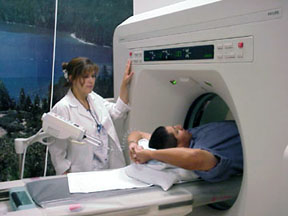The MRI Certificate offered at Oregon Tech Online allows non-degree students and radiology students to gain a valuable understanding of magnetic resonance imaging.
About Our Program
When it comes to presenting the physics of MRI, the fundamentals can be edited for brevity, but a student must understand the concepts in enough depth that the formation of the MR signal and the manipulations that control image contrast make sense! The only comparable subject in the Radiologic Science curriculum is the physics of radiology. Like voltage, amperage, capacitance, induction and the like, the physics of MR deals with quantities unseen, that most people are totally unaware of. As Arthur C. Clark famously said, “Any significantly advanced technology Appears to be magic.”
The certificate in MRI was designed to demystify and reveal the Magician’s tricks. The magician practices untold hours to make that card appear, and there are no short cuts to understanding MRI. Reading, thinking, asking questions, and repeating as needed is the key. It’s the old fashioned way, but it’s tried and true.
One other ingredient is required for success, enthusiasm. Pursuing an endeavor such as this is a good indicator of yours’ to start with. If you’re up for the challenge, and looking for a means to provide the opportunity, this may be the program for you. If you’re looking for faculty who know their business, and are not only willing but eager to help you through the rough spots, that’s our commitment. If you want a quality education from a top ranked school, welcome to Oregon Tech!
Common Questions about the MRI Certificate
What are the primary objectives?
To gain the understanding of MRI physics, and the clinical experience to competently perform magnetic resonance examinations safely, accurately and professionally.
What is the goal of the certificate?
In six words and an acronym: to become registered and certified in MRI.
Who is eligible for the program?
To enroll you must hold a current credential approved for the ARRT’s MRI Certification and Registration Post-Primary Pathway and have clinical access to MRI.
Is this a comprehensive study of cross sectional anatomy, the physics of MRI, clinical practice that covers the requirement for application to the ARRT examination, and review to prepare for and take the registry?
Yes.
How is clinical practice accomplished?
There are two ways:
- You have the opportunity to cross train into MRI as OJT, and gain clinical experience as an employed technologist.
- You arrange to be trained on your time.
Who serves as the clinical instructor?
Typically, a supervisor or manager in the MRI department, or a lead technologist. Ideally, the CI will love to teach.
How many hours of clinical time are required?
There is no clock hour requirement. Progress in the externship (MIT 411) is measured by clinical exams captured for application to the ARRT registry.
Why is the clinical practice called an externship?
The origin of that designation goes back to before many of us were born. Its comes from a unique aspect of the Rad Science program at Oregon Tech. On-campus students leave campus their senior year for four terms of clinical practice at sites all over the northwest and beyond. Then they graduate. Since they leave campus they are externing, rather than the more familiar term, interning. But even the spell checker prefers interning!


